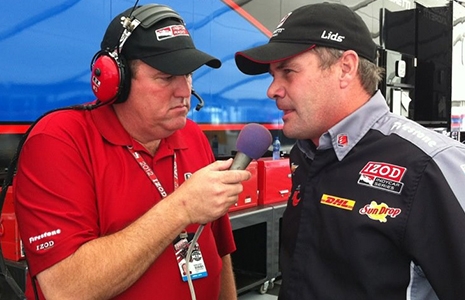INDYCAR Voices: From humble beginnings, Moyer's story is inspiring
APR 27, 2016
In my 21 years with the Advance Auto Parts INDYCAR Radio Network, I’ve had the chance to develop some pretty special relationships with people connected to this sport.
One such relationship began long before I joined the network. It was in 1979, in the hallways of Monrovia High School, a few miles outside Indianapolis. That’s where I first met Kyle Moyer.
When Kyle’s family moved to Indiana, they bought a home across from the late Gary Bettenhausen. Gary and Wavelyn had twin sons, Todd and Cary, who also attended Monrovia. All four of us – Moyer, the Bettenhausen twins and I – graduated high school together in 1982.
Talk about humbling beginnings. While still in high school, Moyer’s motorsports career began sweeping the floors sitting on the attic stairs of Gary B.’s shop in Monrovia and watching him work on his sprint car. From 1980-83, Moyer helped crew the cars Bettenhausen drove for his late brother, Tony, and Moyer almost missed his high school graduation helping Gary qualify a Lindsey Hopkins car for the Indianapolis 500.
In 1984, Moyer left Monrovia and Gary B., packing everything he owned in his car and heading California to work for Dan Gurney and the Gurney/Curb Indy car program. Wavelyn convinced Moyer to make the move. Initially, Gary didn’t think much of it, but eventually gave Moyer his full support. Moyer called it one of the hardest decisions he ever had to make.
From 1984-87, the team would become Curb racing and the driver roster included Tom Sneva, John Andretti, Kevin Cogan and Ed Pimm.
 A move to Hemelgarn Racing in 1988 resulted in a return to Indiana, but his tenure there was brief, leaving after Indy to join Galles Racing. From 1989-92, the Galles-Kraco roster included Bobby Rahal, Danny Sullivan and Moyer’s first Indy 500 win with Al Unser Jr. in 1992.
A move to Hemelgarn Racing in 1988 resulted in a return to Indiana, but his tenure there was brief, leaving after Indy to join Galles Racing. From 1989-92, the Galles-Kraco roster included Bobby Rahal, Danny Sullivan and Moyer’s first Indy 500 win with Al Unser Jr. in 1992.
Forsythe-Green Racing provided the next challenge. In 1993, Moyer headed up the Formula Atlantic program for Jacques Villenueve. The duo graduated to Indy cars in ‘94 and had a breakout year in 1995, with Villenueve winning the Indianapolis 500 and CART championship with Moyer as crew chief.
Moyer’s nine-year run with Forsythe-Green and Team Green included guiding the efforts of Raul Boesel, Parker Johnstone, Paul Tracy and Dario Franchitti.
Along with brothers Barry and Kim Green, Michael Andretti formed Andretti-Green Racing in 2003 and Moyer served as team manager. Through 2010, the team won the Indy 500 in 2005 with Dan Wheldon and 2007 with Franchitti, not to mention Verizon IndyCar Series titles in 2004 (Tony Kanaan), 2005 (Wheldon) and 2007 (Franchitti). Moyer was also the one who made the fuel strategy call that helped Danica Patrick to her only Indy car win at Motegi, Japan, in 2008. (That's me interviewing Moyer for the radio network in the photo at right.)
In 2011, Andretti took sole ownership of the team, retaining Moyer at the helm and he developed the Mazda Road to Indy effort and ran cars in USF2000, Pro Mazda and Indy Lights. The Verizon IndyCar Series program remained stout, picking up a title in 2012 and the 2014 Indy 500 with Ryan Hunter-Reay.
Moyer was faced with another tough decision upon the completion of the 2014 season, much like the one to leave Gary Bettenhausen three decades earlier. Should he accept an offer from Roger Penske’s team? It would mean a move from his long-time Indiana home to Charlotte and leaving an Andretti organization he helped build into prominence.
Like many in open-wheel racing, the chance to work for the Captain was always in the back of his mind. So Moyer made the leap and was tabbed to guide the fortunes as race strategist for a fourth Penske car driven by Simon Pagenaud in 2015.
Last season produced mixed results: four top-fives and 132 laps led, but Pagenaud finished 11th in points. Now it appears all have adjusted to “the Penske way.” Through the first four races of 2016, Pagenaud is the points leader behind two straight wins, two runner-up finishes and one Verizon P1 Award pole.
Broadcasters and journalists are supposed to remain neutral. By and large, we do just that. Every now and then, however, a story comes along that makes you a fan. Kyle Moyer’s story is one of those.
There is added joy in having the privilege of being there for that humble beginning in Monrovia. That kid on Gary Bettenhausen’s stairs in 1979 was on to something. He knew those stairs would lead him to the top.






















